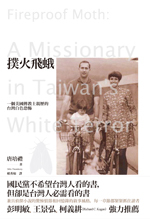昨天有機會碰到一些昔日英雄 :
主講者:唐培禮 先生 是位有文學修養的牧師
主旨是 William Faulkner小說中的人物 我找到兩版本
The past is never dead. It's not even past.
William Faulkner (1897-1962) put it in his Requiem for a nun, "The past is not dead. In fact, it's not even past".

:Fireproof Moth:「撲火飛蛾:一個美國傳教士親歷的台灣白色恐怖」
此書據說是原來未兒孫講故事的信中改編的
張炎憲教授說寫他們資助彭明敏逃亡的第二部最精采 其實第三部透過日本的檔案的暴力革命的現身說法也很有意思
凱達格蘭學校張富美 校長 很有脈絡
謝聰敏先生先生是老英雄
封面中的這對佳偶 因事被台美官方遣返回美國之後離異
"校友會"選的翻譯者表現稍微沒經驗 他應該細心聽講 而不是想看講稿
----
HC: .....打電話來 一項重點是:希望先讀你的年譜‧自傳 好寫文章
Tony:他要如何寫我是出自他的感覺。 我的年譜應該沒有參考作用。
| 【生命之詩】 |

■ 播出時間:
 4/15(週日)中午12點半首播 / 晚間12點重播
4/15(週日)中午12點半首播 / 晚間12點重播南韓國寶級影后尹靜姬睽違十六年重返大銀幕之作,獲得2010韓國青龍獎最佳女演員獎,2010坎城影展最佳劇本獎。這部國際大導演李滄東的最新作品,在坎城首映結束時讓全場觀眾鼓掌長達7分鐘,久久不能自己。
美子(尹靜姬飾)與就讀中學的外孫相依為命,住在郊區的他們,生活平靜愜意。穿著打扮總予人優雅端莊印象的美子,有一天忽然想要將生活中種種美好事物,以詩歌的形式紀錄下來…
 為
了尋找寫詩的靈感,美子開始注意到以往忽略的生活諸多細節,這使她像個孩子般雀躍,彷彿世界處處有驚喜…。可惜美麗不是永恆的,當老年失智症纏上身,加上
漸漸發現生活中有許多甩不開的不愉快,甚至骯髒的事情。鎮上發生了一起少女自殺命案,美子意外地與這件刑案產生關連,當她越想觀察生命中的好美事物,卻越
是體會到無奈與壓迫…
為
了尋找寫詩的靈感,美子開始注意到以往忽略的生活諸多細節,這使她像個孩子般雀躍,彷彿世界處處有驚喜…。可惜美麗不是永恆的,當老年失智症纏上身,加上
漸漸發現生活中有許多甩不開的不愉快,甚至骯髒的事情。鎮上發生了一起少女自殺命案,美子意外地與這件刑案產生關連,當她越想觀察生命中的好美事物,卻越
是體會到無奈與壓迫… 尹
靜姬是在南韓影壇縱橫將近30年的國寶女星,在1994年息影、隨家庭旅居法國,直到因為李滄東導演的力邀,決定破例復出。她以完全出神入化的演技貫穿全
片,每一幕戲都無不令人感到震撼及感動。隔代教養的祖母、老人失智症的病徵、夾雜在醜陋命案與追尋美好創作的心靈,每一個微小的戲劇轉折,都詮釋得淋漓盡
致。
尹
靜姬是在南韓影壇縱橫將近30年的國寶女星,在1994年息影、隨家庭旅居法國,直到因為李滄東導演的力邀,決定破例復出。她以完全出神入化的演技貫穿全
片,每一幕戲都無不令人感到震撼及感動。隔代教養的祖母、老人失智症的病徵、夾雜在醜陋命案與追尋美好創作的心靈,每一個微小的戲劇轉折,都詮釋得淋漓盡
致。 多
次於坎城、威尼斯獲獎的韓國導演李滄東,年輕時從事劇場工作,後來轉戰文壇,成為韓國文學獎得獎作家,也曾在高中任教,2002年還出任韓國文化部長。兩
部作品《綠洲》(Oasis)和《密陽》(Secret
Sunshine)分別在威尼斯和坎城影展大放異彩,讓李滄東蜚聲國際,也讓觀眾欣賞到有別於大部份韓國類型電影的濃烈煽情外,另一種充滿人文風采溫柔卻
又犀利的觀察。做為一個導演和劇作家,李滄東擅長在小人物中取材,藉由對這些生命的描摹詮釋,完成他所想表達的人性觀點。
多
次於坎城、威尼斯獲獎的韓國導演李滄東,年輕時從事劇場工作,後來轉戰文壇,成為韓國文學獎得獎作家,也曾在高中任教,2002年還出任韓國文化部長。兩
部作品《綠洲》(Oasis)和《密陽》(Secret
Sunshine)分別在威尼斯和坎城影展大放異彩,讓李滄東蜚聲國際,也讓觀眾欣賞到有別於大部份韓國類型電影的濃烈煽情外,另一種充滿人文風采溫柔卻
又犀利的觀察。做為一個導演和劇作家,李滄東擅長在小人物中取材,藉由對這些生命的描摹詮釋,完成他所想表達的人性觀點。文化看板-舊香居台大店開幕
舊香居台大店(台北市新生南路三段88號2樓之1)近日開幕,以古書文獻、信札史料為主,未來展售古書、字畫、信札、老照片、地圖等文獻史料,15日(日)15:00舉辦開幕茶會。
我近三點才去逛一下 老闆說原來要弄5000本 來不及 只先展出約2000本
目前有 胡適紀念集 (學生書店) 淮南王書(新月) 藏暉室札記等等....
我近三點才去逛一下 老闆說原來要弄5000本 來不及 只先展出約2000本
目前有 胡適紀念集 (學生書店) 淮南王書(新月) 藏暉室札記等等....
| ||||
補充:
|
2013.8.11補
「舊書近年確實水漲船高,尤其自由行開放後!但這不代表舊書是文創產業,它是事業、是交流、是珍惜書的價值。」台灣老字號的舊書店「舊香居」台大店昨日開幕,作為藏書同好的茉莉二手書店執行總監傅月庵呼籲,不要只看到陸客帶來的購買力,而要保持台灣舊書市場的主體性。
不諱言開展新店是為了接待日益熱絡的舊書收藏者,其中又大多數是陸客,「舊香居」第二代經營者吳雅慧表示:「其實我們一直以來就是看準做華人生意,尤其文化是沒有分國界的。」新店座落在新生南路台大文教區內,附近有繁、簡體、二手書店,對開放自由行後有意深入巷弄的文化人、學者而言,自成一股聚集的吸引力。昨日「舊香居」台大店開幕,包括大陸紀實作家岳南、台灣作家張典婉等均到場。
傅月庵觀察,台灣在華文地區是最適合發展舊書拍賣會的地方,既有豐富而一脈相承的史料,亦有較成熟的藏書文化,面對近年大陸藏書家或掮客重金來台購書,傅月庵樂觀以對:「現在大陸藏書客來台,就如同80年代台灣去大陸收購舊書。台灣的風氣已是藏書而非投資。」未來,他相信藏書市場會更看重價值而非價錢。
吳雅慧指出,目前看來大陸藏書愛好者仍對台灣的傳記、文史和藝術類舊書最感興趣,單一作者近期則以西西和甫獲行政院文化獎的林文月詢問度最高。她認為陸客來台尋寶,最大的幫助還不在於帶來的業績,而是讓台灣的藏書市場再度受到刺激,讓愈來愈多人懂得珍惜家中所留存的舊書。
Read more: http://www.want-daily.com/portal.php?mod=view&aid=18176#ixzz2bf9KC3CE
Little Europe on the Outskirts of Shanghai


Spanish photographer Pablo Conejo traveled to China to document
the rapid—and, he thought, almost unsustainable—development of a
country full of contradictions, the result of Chinese culture
confronting global trends. Before his trip, he made a list of opposite
concepts to accompany him as an inspiration: east and west, poverty and
wealth, communism and capitalism and tradition and modernity were all
ideas that served as guides in the photographer’s anthropological
excursion. In Shanghai, he saw yet another contradiction.
Conejo found himself immersed in a futuristic urban landscape, a skyline overloaded with concrete and glass above the smell and feel of the stereotypical China he expected to find, one that he describes as a “tangle of motorcycles, cars, people and noise; a mix of intense food smell from stalls and kitchens, car fumes and a murmur from all this bustle; all this jumble peppered with red lanterns and fortune cats.” Then, as he reached the borders of the city he found a peculiar urban project: a set of nine suburban neighborhoods under construction, mimicking the architectural styles of several iconic European countries, including France, the United Kingdom, Sweden, Holland and Germany. Built to house the wealthier Chinese population escaping the big-city lifestyle, “One City, Nine Towns” is a thematic urban project launched in 2004 with the goal of relieving overpopulation in Shanghai. These artificial towns, which are replicas of buildings found in the various European locales, are projected to house one million people by 2020.
“At the moment all the towns look like ghost cities,” Conejo says. “The empty streets make them look like Disney World or a cinema set. As a matter of fact, Thames Town, the English imitation, is becoming a very popular location to have one’s wedding photography made.” Despite their popularity among locals, Conejo realized that some people weren’t familiar with the original inspirations of these model homes. In the Paris neighborhood, the photographer asked three teenagers if they knew anything about the French capital. “Paris?” one asked. “I don’t know.”
Pablo Conejo, who was born in Madrid in 1981, ran two urban photography workshops in Instituto Europeo di Design in Barcelona in 2008 and 2009. You can see more of his work here.
Conejo found himself immersed in a futuristic urban landscape, a skyline overloaded with concrete and glass above the smell and feel of the stereotypical China he expected to find, one that he describes as a “tangle of motorcycles, cars, people and noise; a mix of intense food smell from stalls and kitchens, car fumes and a murmur from all this bustle; all this jumble peppered with red lanterns and fortune cats.” Then, as he reached the borders of the city he found a peculiar urban project: a set of nine suburban neighborhoods under construction, mimicking the architectural styles of several iconic European countries, including France, the United Kingdom, Sweden, Holland and Germany. Built to house the wealthier Chinese population escaping the big-city lifestyle, “One City, Nine Towns” is a thematic urban project launched in 2004 with the goal of relieving overpopulation in Shanghai. These artificial towns, which are replicas of buildings found in the various European locales, are projected to house one million people by 2020.
“At the moment all the towns look like ghost cities,” Conejo says. “The empty streets make them look like Disney World or a cinema set. As a matter of fact, Thames Town, the English imitation, is becoming a very popular location to have one’s wedding photography made.” Despite their popularity among locals, Conejo realized that some people weren’t familiar with the original inspirations of these model homes. In the Paris neighborhood, the photographer asked three teenagers if they knew anything about the French capital. “Paris?” one asked. “I don’t know.”
Pablo Conejo, who was born in Madrid in 1981, ran two urban photography workshops in Instituto Europeo di Design in Barcelona in 2008 and 2009. You can see more of his work here.
Read more: http://lightbox.time.com/2012/04/02/replicas/#ixzz1s4P408Es

沒有留言:
張貼留言